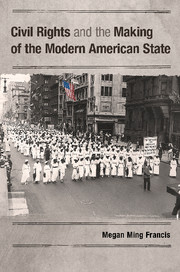Book contents
- Frontmatter
- Dedication
- Contents
- List of Figures and Table
- Illustrations
- Acknowledgments
- Abbreviations
- 1 Rethinking Civil Rights and American Political Development
- 2 The Birth of the NAACP, Mob Violence, and the Challenge of Public Opinion
- 3 The Unsteady March into the Oval Office
- 4 Anti-Lynching Legislation and the Sinking of the Republican Ship in Congress
- 5 Defending the Right to Live
- 6 Civil Rights Bound
- Appendix Manuscript Sources
- Bibliography
- Index
- References
6 - Civil Rights Bound
Published online by Cambridge University Press: 05 June 2014
- Frontmatter
- Dedication
- Contents
- List of Figures and Table
- Illustrations
- Acknowledgments
- Abbreviations
- 1 Rethinking Civil Rights and American Political Development
- 2 The Birth of the NAACP, Mob Violence, and the Challenge of Public Opinion
- 3 The Unsteady March into the Oval Office
- 4 Anti-Lynching Legislation and the Sinking of the Republican Ship in Congress
- 5 Defending the Right to Live
- 6 Civil Rights Bound
- Appendix Manuscript Sources
- Bibliography
- Index
- References
Summary
Government is instituted for the common good; for the protection, safety, prosperity and happiness of the people; and not for the profit, honor, or private interest of any one man, family, or class of men: Therefore the people alone have an incontestable, unalienable, and indefeasible right to institute government; and to reform, alter, or totally change the same, when their protection, safety, prosperity and happiness require it.
– John Adams, Samuel Adams, and James Bowdoin, 1780Late in the evening of March 30, 1934, Arthur Ellington, an African American farmer, was accused of murdering a white planter. He denied committing the crime, only to have a white mob surround him, place a rope around his neck, and hang him from the branch of a tree. Maintaining his innocence while gasping for air, he was released from the noose, beaten until blood flowed, then returned to the tree until he was near death – but released again. After the spectacle, Ellington was let go for a day but then picked up at his residence and formally arrested by the deputy. While transporting Ellington to the county jail, the deputy pulled to the side of the road to unleash another excruciating beating on the already bruised body, declaring that the whipping would not stop until Ellington confessed, which he eventually agreed to do. The deputy likewise rounded up two more African American tenant farmers, Ed Brown and Henry Shields, as coconspirators in the murder. Once in custody, Brown and Shields were forced to strip naked and then beaten with leather straps with buckles until their backs were badly cut. The merciless punishment stopped only when they ended their pleas of innocence and agreed to go along with the deputy’s version of events.
- Type
- Chapter
- Information
- Civil Rights and the Making of the Modern American State , pp. 164 - 184Publisher: Cambridge University PressPrint publication year: 2014

